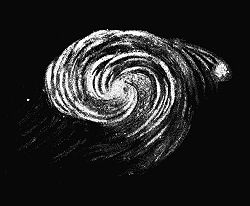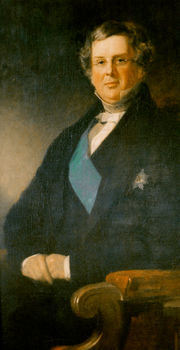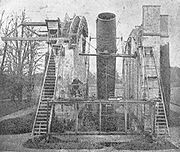
William Parsons, 3rd Earl of Rosse
Encyclopedia
William Parsons, 3rd Earl of Rosse, Knight of the Order of St Patrick (KP) (17 June 1800 – 31 October 1867) was an Irish astronomer who had several telescopes built. His 72-inch telescope "Leviathan", built 1845, was the world's largest telescope until the early 20th century.
, England, in the city of York
, the son of an Irish peer. He was educated at Trinity College, Dublin
, and Oxford University's Magdalen College
, graduating with first-class honors in mathematics in 1822. He inherited an earldom and a large estate in King's County
(now County Offaly) in Ireland when his father Lawrence Parsons, 2nd Earl of Rosse died in 1841.
Rosse married Mary Field
, daughter of John Wilmer Field, on 14 April 1836. They had four children:
In addition to his astronomical interests, Rosse served as an Member of Parliament
(MP) for King's County
from 1821 to 1834, an Irish representative peer after 1845, president of the Royal Society
(1848–1854), and chancellor of Trinity College, Dublin
(1862–1867).
built, a 72-inch (6 feet/1.83 m) telescope at Birr Castle
, Parsonstown, County Offaly. The 72 inches (1.8 m) telescope replaced a 36 inches (914.4 mm) telescope that he had built previously.
He had to invent many of the techniques he used for constructing the Leviathan, both because its size was without precedent and because earlier telescope builders had guarded their secrets or had simply failed to publish their methods. Rosse's telescope was considered a marvelous technical and architectural achievement, and images of it were circulated widely within the British commonwealth. Building of the Leviathan began in 1845 and it was first used in 1847. It was the world's largest telescope until the early 20th century. Using this telescope Rosse saw and cataloged a large number of galaxies.
 Lord Rosse performed astronomical studies and discovered the spiral nature of some nebula
Lord Rosse performed astronomical studies and discovered the spiral nature of some nebula
s, today known to be spiral galaxies
. Rosse's telescope Leviathan was the first to reveal the spiral structure of M51, a galaxy nicknamed later as the "Whirlpool Galaxy
", and his drawings of it closely resemble modern photographs.
Rosse named the Crab Nebula
, based on an earlier drawing made with his older 36-inch (91 cm) telescope in which it resembled a crab. A few years later, when the 72-inch (183 cm) telescope was in service, he produced an improved drawing of considerably different appearance, but the original name continued to be used.
 A main component of Rosse's nebular research was attempting to resolve the nebular hypothesis, which posited that planets and stars were formed by gravity acting on gaseous nebulae. Rosse himself did not believe that nebulas were truly gaseous, but rather that they were made of such an amount of fine stars that most telescopes could not resolve them individually (that is, he considered nebulas to be stellar in nature). Rosse and his technicians claimed to resolve the Orion nebula
A main component of Rosse's nebular research was attempting to resolve the nebular hypothesis, which posited that planets and stars were formed by gravity acting on gaseous nebulae. Rosse himself did not believe that nebulas were truly gaseous, but rather that they were made of such an amount of fine stars that most telescopes could not resolve them individually (that is, he considered nebulas to be stellar in nature). Rosse and his technicians claimed to resolve the Orion nebula
into its individual stars, which would have cosmological and even philosophical implications, as at the time there was considerable debate over whether or not the universe was "evolved" (in a pre-Darwinian sense), a concept with which Rosse disagreed strongly. Rosse's primary opponent in this was John Herschel
, who used his own instruments to claim that the Orion nebula was a "true" nebula, and discounted Rosse's instruments as flawed (a criticism Rosse returned about Herschel's own). Eventually, neither man (nor telescope) could establish sufficiently scientific results to resolve the question (the convincing evidence for the gaseous nature of the nebula would be developed later from spectroscopic evidence, though it would not resolve the philosophical issues).
 One of Rosse's telescope admirers was Thomas Langlois Lefroy
One of Rosse's telescope admirers was Thomas Langlois Lefroy
, a fellow Irish MP, who said, "The planet Jupiter, which through an ordinary glass is no larger than a good star, is seen twice as large as the moon appears to the naked eye... But the genius displayed in all the contrivances for wielding this mighty monster even surpasses the design and execution of it. The telescope weighs sixteen tons, and yet Lord Rosse raised it single-handed off its resting place, and two men with ease raised it to any height."
Lord Rosse's son published his father's findings, including the discovery of 226 NGC objects in the publication Observations of Nebulae and Clusters of Stars Made With the Six-foot and Three-foot Reflectors at Birr Castle From the Year 1848 up to the Year 1878, Scientific Transactions of the Royal Dublin Society Vol. II, 1878.
ground parabolically and polished.
Life
He was born in YorkshireYorkshire
Yorkshire is a historic county of northern England and the largest in the United Kingdom. Because of its great size in comparison to other English counties, functions have been increasingly undertaken over time by its subdivisions, which have also been subject to periodic reform...
, England, in the city of York
York
York is a walled city, situated at the confluence of the Rivers Ouse and Foss in North Yorkshire, England. The city has a rich heritage and has provided the backdrop to major political events throughout much of its two millennia of existence...
, the son of an Irish peer. He was educated at Trinity College, Dublin
Trinity College, Dublin
Trinity College, Dublin , formally known as the College of the Holy and Undivided Trinity of Queen Elizabeth near Dublin, was founded in 1592 by letters patent from Queen Elizabeth I as the "mother of a university", Extracts from Letters Patent of Elizabeth I, 1592: "...we...found and...
, and Oxford University's Magdalen College
Magdalen College, Oxford
Magdalen College is one of the constituent colleges of the University of Oxford in England. As of 2006 the college had an estimated financial endowment of £153 million. Magdalen is currently top of the Norrington Table after over half of its 2010 finalists received first-class degrees, a record...
, graduating with first-class honors in mathematics in 1822. He inherited an earldom and a large estate in King's County
County Offaly
County Offaly is a county in Ireland. It is part of the Midlands Region and is also located in the province of Leinster. It is named after the ancient Kingdom of Uí Failghe and was formerly known as King's County until the establishment of the Irish Free State in 1922. Offaly County Council is...
(now County Offaly) in Ireland when his father Lawrence Parsons, 2nd Earl of Rosse died in 1841.
Rosse married Mary Field
Mary rosse
Mary Rosse, Countess of Rosse , was a British amateur astronomer and pioneering photographer. She was one of the early practitioners of making photographs from waxed-paper negatives.- Life :...
, daughter of John Wilmer Field, on 14 April 1836. They had four children:
- Lawrence Parsons, 4th Earl of RosseLawrence Parsons, 4th Earl of RosseLawrence Parsons, 4th Earl of Rosse KP FRS was the son and successor of the astronomer William Parsons, 3rd Earl of Rosse who built the "Leviathan of Parsonstown" telescope, largest of its day, and his wife, the Countess Rosse , an amateur astronomer and pioneering photographer...
(17 November 1840 – 30 August 1908). - Reverend Randal Parsons (26 April 1848 – 15 November 1936).
- Hon. Richard Clere Parsons (21 February 1851 – 26 January 1923), apparently known for developing railways in South America.
- Sir Charles Algernon ParsonsCharles Algernon ParsonsSir Charles Algernon Parsons OM KCB FRS was an Anglo-Irish engineer, best known for his invention of the steam turbine. He worked as an engineer on dynamo and turbine design, and power generation, with great influence on the naval and electrical engineering fields...
(13 June 1854 – 11 February 1931), known for inventing the steam turbineSteam turbineA steam turbine is a mechanical device that extracts thermal energy from pressurized steam, and converts it into rotary motion. Its modern manifestation was invented by Sir Charles Parsons in 1884....
.
In addition to his astronomical interests, Rosse served as an Member of Parliament
Member of Parliament
A Member of Parliament is a representative of the voters to a :parliament. In many countries with bicameral parliaments, the term applies specifically to members of the lower house, as upper houses often have a different title, such as senate, and thus also have different titles for its members,...
(MP) for King's County
King's County (UK Parliament constituency)
King's County was a parliamentary constituency in Ireland, represented in the House of Commons of the United Kingdom. It return two Members of Parliament 1801–1885 and one in 1918–1922.-Boundaries:...
from 1821 to 1834, an Irish representative peer after 1845, president of the Royal Society
Royal Society
The Royal Society of London for Improving Natural Knowledge, known simply as the Royal Society, is a learned society for science, and is possibly the oldest such society in existence. Founded in November 1660, it was granted a Royal Charter by King Charles II as the "Royal Society of London"...
(1848–1854), and chancellor of Trinity College, Dublin
Trinity College, Dublin
Trinity College, Dublin , formally known as the College of the Holy and Undivided Trinity of Queen Elizabeth near Dublin, was founded in 1592 by letters patent from Queen Elizabeth I as the "mother of a university", Extracts from Letters Patent of Elizabeth I, 1592: "...we...found and...
(1862–1867).
Scientific studies
During the 1840s, he had the Leviathan of ParsonstownLeviathan of Parsonstown
Leviathan of Parsonstown is the unofficial name of the Rosse six foot telescope. This is a historic reflecting telescope of 72 in aperture, which was the largest telescope in the world from 1845 until the construction of the 100 in Hooker Telescope in 1917...
built, a 72-inch (6 feet/1.83 m) telescope at Birr Castle
Birr Castle
Birr Castle is a large castle in the town of Birr in County Offaly, Ireland. It is the home of the seventh Earl of Rosse, and as such the residential areas of the castle are not open to the public, though the grounds and gardens of the demesne are publicly accessible.-Ireland's Historic Science...
, Parsonstown, County Offaly. The 72 inches (1.8 m) telescope replaced a 36 inches (914.4 mm) telescope that he had built previously.
He had to invent many of the techniques he used for constructing the Leviathan, both because its size was without precedent and because earlier telescope builders had guarded their secrets or had simply failed to publish their methods. Rosse's telescope was considered a marvelous technical and architectural achievement, and images of it were circulated widely within the British commonwealth. Building of the Leviathan began in 1845 and it was first used in 1847. It was the world's largest telescope until the early 20th century. Using this telescope Rosse saw and cataloged a large number of galaxies.

Nebula
A nebula is an interstellar cloud of dust, hydrogen gas, helium gas and other ionized gases...
s, today known to be spiral galaxies
Galaxy
A galaxy is a massive, gravitationally bound system that consists of stars and stellar remnants, an interstellar medium of gas and dust, and an important but poorly understood component tentatively dubbed dark matter. The word galaxy is derived from the Greek galaxias , literally "milky", a...
. Rosse's telescope Leviathan was the first to reveal the spiral structure of M51, a galaxy nicknamed later as the "Whirlpool Galaxy
Whirlpool Galaxy
The Whirlpool Galaxy is an interacting grand-design spiral galaxy that is estimated to be 23 ± 4 million light-years from the Milky Way Galaxy. in the constellation Canes Venatici...
", and his drawings of it closely resemble modern photographs.
Rosse named the Crab Nebula
Crab Nebula
The Crab Nebula is a supernova remnant and pulsar wind nebula in the constellation of Taurus...
, based on an earlier drawing made with his older 36-inch (91 cm) telescope in which it resembled a crab. A few years later, when the 72-inch (183 cm) telescope was in service, he produced an improved drawing of considerably different appearance, but the original name continued to be used.

Orion Nebula
The Orion Nebula is a diffuse nebula situated south of Orion's Belt. It is one of the brightest nebulae, and is visible to the naked eye in the night sky. M42 is located at a distance of and is the closest region of massive star formation to Earth. The M42 nebula is estimated to be 24 light...
into its individual stars, which would have cosmological and even philosophical implications, as at the time there was considerable debate over whether or not the universe was "evolved" (in a pre-Darwinian sense), a concept with which Rosse disagreed strongly. Rosse's primary opponent in this was John Herschel
John Herschel
Sir John Frederick William Herschel, 1st Baronet KH, FRS ,was an English mathematician, astronomer, chemist, and experimental photographer/inventor, who in some years also did valuable botanical work...
, who used his own instruments to claim that the Orion nebula was a "true" nebula, and discounted Rosse's instruments as flawed (a criticism Rosse returned about Herschel's own). Eventually, neither man (nor telescope) could establish sufficiently scientific results to resolve the question (the convincing evidence for the gaseous nature of the nebula would be developed later from spectroscopic evidence, though it would not resolve the philosophical issues).

Thomas Langlois Lefroy
Thomas Langlois Lefroy was an Irish-Huguenot politician and judge. He served as an MP for the constituency of Dublin University 1830–1841, Privy Councillor of Ireland 1835–1869 and Lord Chief Justice of Ireland 1852–1866....
, a fellow Irish MP, who said, "The planet Jupiter, which through an ordinary glass is no larger than a good star, is seen twice as large as the moon appears to the naked eye... But the genius displayed in all the contrivances for wielding this mighty monster even surpasses the design and execution of it. The telescope weighs sixteen tons, and yet Lord Rosse raised it single-handed off its resting place, and two men with ease raised it to any height."
Lord Rosse's son published his father's findings, including the discovery of 226 NGC objects in the publication Observations of Nebulae and Clusters of Stars Made With the Six-foot and Three-foot Reflectors at Birr Castle From the Year 1848 up to the Year 1878, Scientific Transactions of the Royal Dublin Society Vol. II, 1878.
Lord Rosse's telescopes
Lord Rosse had a variety of optical reflecting telescopes built. Rosse's telescopes used cast speculum metalSpeculum metal
Speculum metal is a mixture of around two-thirds copper and one-third tin making a white brittle alloy that can be polished to make a highly reflective surface. It is used primarily to make different kinds of mirrors including early reflecting telescope optical mirrors...
ground parabolically and polished.
- 15-inch (38 cm)
- 24-inch (61 cm)
- 36-inch (91 cm) (aka Rosse 3-foot telescope)
- 72-inch (180 cm) (aka Rosse 6-foot telescope or Leviathan), started in 1842 and completed in 1845.

